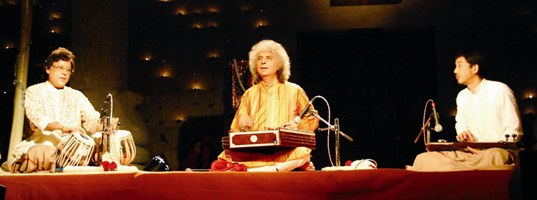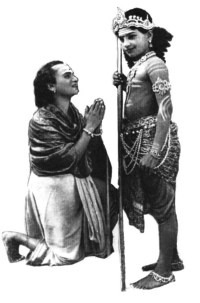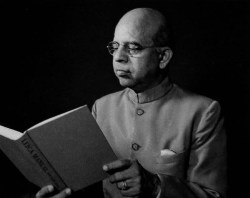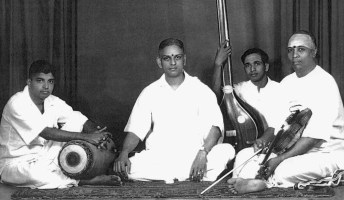NEWS & NOTES

NATYA SANGRAHAM 2010 Dance camp at Thennangur - KARUNA SAGARI What does a dancer do with her time, apart from dancing? She needs to do a lot of explaining and talking as part of daily life, ever afraid of using technical words and dancer’s jargon, forever desperately trying not to sound alien to a listener, be it a student, rasika or passerby who stops to ask about a dancer’s credentials. What did the Thennangur camp Natya Sangraham give us? The dancer’s space, where dancers could freely express themselves through the language of dance (with the assurance that it would be paid attention). Where various levels of abstraction brought to practicality could be discussed. Where we could build castles from an already existing platform. A bus waited at Narada Gana Sabha to take 28 dancers from various schools of dance and thought, along with many of the organisers and teachers. We were very warmly welcomed by the Narada Gana Sabha committee members, while it was evident that the air was filled with nervousness (of young dancers who were first timers), excitement (at meeting dancers whom you have seen only on stage) and veterans (people you thought you’d never meet!). It was also encouraging to see the warmth and ease with which the seniors interacted with the youngsters.
COVER STORY

M.K. TYAGARAJA BHAGAVATAR He took classical music to the masses - VAMANAN MKT Bhagavatar – his was the story of south India’s greatest singing star in the infant decades of Tamil cinema. “Bhagavatar,” says Prof. P. Sambamoorthy in his Dictionary of South Indian Music and Musicians, ‘‘is the name given to performers of katha kalakshepam or religious discourses to the accompaniment of music. In Malabar, music teachers and professional musicians are called Bhagavatars”. That explains why in Tamil Nadu we have a Soolamangalam Vaidyanatha Bhagavatar and a Mangudi Chidambara Bhagavatar, both masters in musical discourse, and from Kerala a Chembai Vaidyanatha Bhagavatar. But how did a film star come to be called Tyagaraja Bhagavatar or just Bhagavatar? The Tamil lexicon explains that the word primarily refers either to worshippers of Vishnu or those who expound religious stories to the accompaniment of music. It adds that in its secondary signification, the word may refer to those proficient in music, as well as to music teachers and singers. This could explain why the title ‘Bhagavatar’ stuck to Tyagaraja in the drama and film world. Music was the most powerful expression of his art, and even though his stage and cinematic presence was stunning, it was his song that the world looked up to. On his part, Bhagavatar too had sought to hone his music from a very young age. He befriended musicians and benefited from their art. From the drama stage, on the concert platform and from his celluloid peak, his musical art took the power, beauty and fragrance of Carnatic raga to millions of people. That was why ‘Bhagavatar’ became his very name and a byword for the best of music.
SPECIAL FEATURE

DR. V. RAGHAVAN Renaissance man - S. JANAKI This is the second part of a special centenary feature on the late Dr. V. Raghavan (Photos courtesy his daughter Nandini Ramani). The first part focusing on his role in the Music Academy, Madras, was published in Sruti 302. “The name of Raghavan is a legend in the revival of studies into ancient Indian culture. When our country had lost its memories of the past, Dr. Raghavan brought back the original thoughts. Those of us who had no identity, because of our English education, began to look into the Indian soul through the writings of this man who is more than a Professor of Sanskrit, but perhaps a doyen of renewed consciousness. What has he not taught us: classical music, the most ancient dances and some of the wisdom of the forest books….” This is an excerpt from the felicitation written by famous writer Mulk Raj Anand on the occasion of Dr. V. Raghavan’s 60th birthday in August 1968. It truly sums up the man and his mission whose birth centenary was celebrated for a year starting August 2008.
GNB CENTENARY

From young vidwan to Sangita Kalanidhi - LALITHA RAM “The Music Academy draws more visitors to its canteen than its concerts. Those who want to show off their zari veshtis and silk sarees outnumber genuine music lovers.” My friend was unstoppable in his attack on the Academy. “The place is so full of restrictions – a musician has to stop his concert in exactly two and a half hours; he must provide an advance list of songs he’s going to perform, so on and so forth.” “Stop spewing venom on the Academy,” I told him. “It has been responsible for so many good deeds,” I continued, but he was not to be assuaged. “Tell me one good thing the Academy has done.” I knew him well; I knew what would silence him. “Wasn’t the Academy responsible for the wonderful artist GNB taking to music full time?” I said. My friend was silenced.


